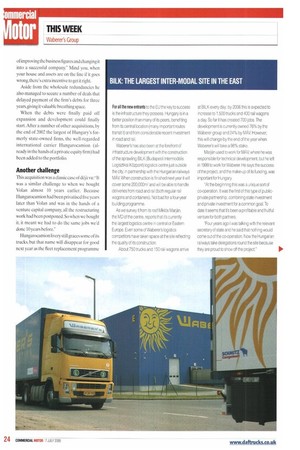BILK: THE LARGEST INTER-MODAL SITE IN THE EAST
Page 24

If you've noticed an error in this article please click here to report it so we can fix it.
For all the new entrants to the EU the key to success is the infrastructure they possess. Hungary is in a better position than many of its peers, benefiting from its central location (many important routes transit it) and from considerable recent investment in road and rail.
Waberer's has also been at the forefront of infrastructure development with the construction of the sprawling BILK (Budapesti Interrnodalis Logisztikai KOzpont) logistics centre just outside the city, in partnership with the Hungarian railways MAV. When construction is finished next year it will cover some 200,000m2 and will be able to handle deliveries from road and rail (both regular rail wagons and containers). Not bad for a four-year building programme.
As we survey it from its roof Miklos Marjan, the MD of the centre, reports that its currently the largest logistics centre in central or Eastern Europe. Even some of Waberer's logistics competitors have taken space at the site reflecting the quality of its construction.
About 750 trucks and 150 rail wagons arrive at BILK every day, by 2006 this is expected to increase to 1,500 trucks and 400 rail wagons a day. So far it has created 700 jobs. The development is currently owned 76% by the Waberer group and 24% by MAV. However, this will change by the end of the year when Waberer's will take a 98% stake.
Madan used to work for MAV, where he was responsible for technical development, but he left in 1999 to work for Waberer. He says the success of the project, and the make-up of its funding, was important for Hungary.
"At the beginning this was a unique sort of co-operation. it was the first of this type of publicprivate partnership. combining state investment and private investment for a common goal. To date it seems that it's been a prof itable and fruitful venture for both partners.
"Four years ago I was talking with the relevant secretary of state and he said that nothing would come out of the co-operation. Now the Hungarian railways take delegations round the site because they are proud to show off the project."










































































































































































































